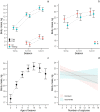Long-term capture and handling effects on body condition, reproduction and survival in a semi-aquatic mammal
- PMID: 33087816
- PMCID: PMC7578049
- DOI: 10.1038/s41598-020-74933-w
Long-term capture and handling effects on body condition, reproduction and survival in a semi-aquatic mammal
Abstract
In long-term individual-based field studies, several parameters need to be assessed repeatedly to fully understand the potential fitness effects on individuals. Often studies only evaluate capture stress that appears in the immediate weeks or breeding season and even long-term studies fail to evaluate the long-term effects of their capture procedures. We investigated effects of long-term repeated capture and handling of individuals in a large semi-aquatic rodent using more than 20 years of monitoring data from a beaver population in Norway. To investigate the effects, we corrected for ecological factors and analysed the importance of total capture and handling events, years of monitoring and deployment of telemetry devices on measures related to body condition, reproduction and survival of individual beavers. Body mass of dominant individuals decreased considerably with number of capture events (107 g per capture), but we found no statistically clear short or long-term effects of capture and handling on survival or other body condition indices. Annual litter size decreased with increasing number of captures among older individuals. Number of captures furthermore negatively affected reproduction in the beginning of the monitoring, but the effect decreased over the years, indicating habituation to repeated capture and handling. By assessing potential impacts on several fitness-related parameters at multiple times, we can secure the welfare of wild animal populations when planning and executing future conservation studies as well as ensure ecologically reliable research data.
Conflict of interest statement
The authors declare no competing interests.
Figures






Similar articles
-
The impact of bio-logging on body weight change of the Eurasian beaver.PLoS One. 2021 Dec 23;16(12):e0261453. doi: 10.1371/journal.pone.0261453. eCollection 2021. PLoS One. 2021. PMID: 34941892 Free PMC article.
-
Elevated basal corticosterone levels increase disappearance risk of light but not heavy individuals in a long-term monitored rodent population.Horm Behav. 2019 Jul;113:95-102. doi: 10.1016/j.yhbeh.2019.05.001. Epub 2019 May 22. Horm Behav. 2019. PMID: 31077709
-
Proximate weather patterns and spring green-up phenology effect Eurasian beaver (Castor fiber) body mass and reproductive success: the implications of climate change and topography.Glob Chang Biol. 2013 Apr;19(4):1311-24. doi: 10.1111/gcb.12114. Epub 2013 Jan 25. Glob Chang Biol. 2013. PMID: 23504905
-
Photoperiodic polyphenisms in rodents: neuroendocrine mechanisms, costs, and functions.Q Rev Biol. 2001 Sep;76(3):293-325. doi: 10.1086/393989. Q Rev Biol. 2001. PMID: 11561508 Review.
-
Hibernation and circannual rhythms of food consumption in marmots and ground squirrels.Q Rev Biol. 1976 Dec;51(4):477-514. doi: 10.1086/409594. Q Rev Biol. 1976. PMID: 799318 Review.
Cited by
-
Mammals show faster recovery from capture and tagging in human-disturbed landscapes.Nat Commun. 2024 Sep 15;15(1):8079. doi: 10.1038/s41467-024-52381-8. Nat Commun. 2024. PMID: 39278967 Free PMC article.
-
The impact of bio-logging on body weight change of the Eurasian beaver.PLoS One. 2021 Dec 23;16(12):e0261453. doi: 10.1371/journal.pone.0261453. eCollection 2021. PLoS One. 2021. PMID: 34941892 Free PMC article.
-
The impact of stalking hunt season on long-term stress in big game.BMC Vet Res. 2024 Dec 4;20(1):549. doi: 10.1186/s12917-024-04416-x. BMC Vet Res. 2024. PMID: 39633375 Free PMC article.
-
The cost of research: Lasting effects of capture, surgery and muscle biopsy on brown bear (Ursus arctos) movement and physiology.Anim Welf. 2023 Nov 21;32:e75. doi: 10.1017/awf.2023.95. eCollection 2023. Anim Welf. 2023. PMID: 38510989 Free PMC article.
-
Individual recognition of Eurasian beavers (Castor fiber) by their tail patterns using a computer-assisted pattern-identification algorithm.Ecol Evol. 2024 Feb 13;14(2):e10922. doi: 10.1002/ece3.10922. eCollection 2024 Feb. Ecol Evol. 2024. PMID: 38357591 Free PMC article.
References
-
- Jobling M. Are compensatory growth and catch-up growth two sides of the same coin? Aquacult. Int. 2010;18:501–510. doi: 10.1007/s10499-009-9260-8. - DOI
-
- Farias V, Fuller TK, Wayne RK, Sauvajot RM. Survival and cause-specific mortality of gray foxes (Urocyon cinereoargenteus) in southern California. J. Zool. 2005;266:249–254. doi: 10.1017/S0952836905006850. - DOI
-
- Arnemo JM, et al. Risk of capture-related mortality in large free-ranging mammals: experiences from Scandinavia. Wildl. Biol. 2006;12:109–113. doi: 10.1017/S0952836901000309. - DOI
Publication types
MeSH terms
LinkOut - more resources
Full Text Sources
Medical

